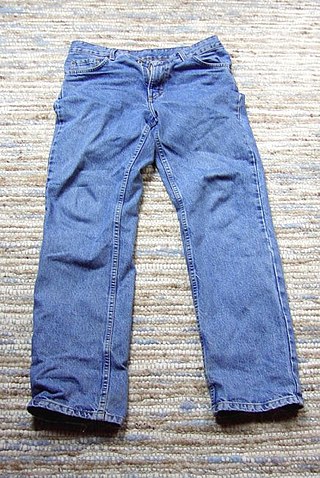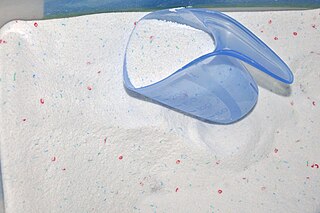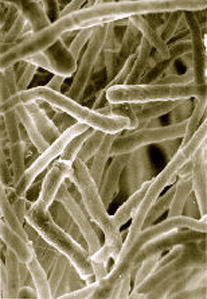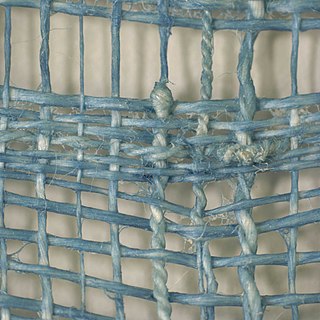
Jeans are a type of pants or trousers made from denim or dungaree cloth. Often the term "jeans" refers to a particular style of trousers, called "blue jeans", with copper-riveted pockets which were invented by Jacob W. Davis in 1871 and patented by Davis and Levi Strauss on May 20, 1873. Prior to the patent, the term "blue jeans" had been long in use for various garments, constructed from blue-colored denim.

Tie-dye is a term used to describe a number of resist dyeing techniques and the resulting dyed products of these processes. The process of tie-dye typically consists of folding, twisting, pleating, or crumpling fabric or a garment, before binding with string or rubber bands, followed by the application of dye or dyes. The manipulations of the fabric before the application of dye are called resists, as they partially or completely prevent ('resist') the applied dye from coloring the fabric. More sophisticated tie-dye may involve additional steps, including an initial application of dye before the resist, multiple sequential dyeing and resist steps, and the use of other types of resists and discharge.

Dyeing is the application of dyes or pigments on textile materials such as fibers, yarns, and fabrics with the goal of achieving color with desired color fastness. Dyeing is normally done in a special solution containing dyes and particular chemical material. Dye molecules are fixed to the fiber by absorption, diffusion, or bonding with temperature and time being key controlling factors. The bond between the dye molecule and fiber may be strong or weak, depending on the dye used. Dyeing and printing are different applications; in printing, color is applied to a localized area with desired patterns. In dyeing, it is applied to the entire textile.

Laundry detergent is a type of detergent used for cleaning dirty laundry (clothes). Laundry detergent is manufactured in powder and liquid form.

Textile printing is the process of applying color to fabric in definite patterns or designs. In properly printed fabrics the colour is bonded with the fibre, so as to resist washing and friction. Textile printing is related to dyeing but in dyeing properly the whole fabric is uniformly covered with one colour, whereas in printing one or more colours are applied to it in certain parts only, and in sharply defined patterns.

Marithé + François Girbaud is an international clothing company based in France and founded by stylists François Girbaud and Marithé Bachellerie in 1972. They created several brands : Compagnie des montagnes et des forêts, Ça, Closed, Matricule 11342, etc. They are world-known especially for industrialization of the stonewash, baggy trousers and skin-tight jeans.

Fashion of the 1980s was characterized by a rejection of 1970s fashion. Punk fashion began as a reaction against both the hippie movement of the past decades and the materialist values of the current decade. The first half of the decade was relatively tame in comparison to the second half, which was when apparel became very bright and vivid in appearance.

A denim skirt, sometimes referred to as a 'jean skirt' or 'jeans skirt', is a skirt made of denim, the same material as blue jeans. Denim skirts come in a variety of styles and lengths to suit different populations and occasions. For example, full-length denim skirts are commonly worn by women whose religious beliefs prohibit them from wearing trousers, including Orthodox Jews, some Muslims, Mennonites, and Pentecostals, among others. Shorter skirts made of denim are commonly worn by teenagers and young adults.

Trichoderma viride is a fungus and a biofungicide.

Trichoderma reesei is a mesophilic and filamentous fungus. It is an anamorph of the fungus Hypocrea jecorina. T. reesei can secrete large amounts of cellulolytic enzymes. Microbial cellulases have industrial application in the conversion of cellulose, a major component of plant biomass, into glucose.
The Great Western Garment Company (GWG) was a Canadian denim and western wear clothing company founded in 1911 in Edmonton, Alberta by Charles A. Graham and Alexander Cameron Rutherford (the first Premier of Alberta).

In textile manufacturing, finishing refers to the processes that convert the woven or knitted cloth into a usable material and more specifically to any process performed after dyeing the yarn or fabric to improve the look, performance, or "hand" (feel) of the finish textile or clothing. The precise meaning depends on context.

A denim jacket, also called a jean jacket or trucker jacket, is a jacket made from denim. Introduced in the United States in the late 19th century, it has been a popular type of casual apparel with both men and women and has been described as an iconic element of American fashion. Though a staple of western wear, the denim jacket has also enjoyed a more general appeal.
Frank Mechaly in Marseille, France and raised in St. Tropez, is a jeans designer and brand maker, specializing in premium denim. Though he has successfully launched a number of brands including Sacred Blue and Blue Cult, he is probably best known as the founder and creator of 575 DENIM which has been embraced by celebrities such as Cameron Diaz who made a point of publicly acknowledging her affinity for the jeans during an appearance on Saturday Night Live. Mechaly has now launched his much-anticipated new brand of premium denim called RockStar.
Colour fastness is a term—used in the dyeing of textile materials—that characterizes a material's colour's resistance to fading or running. Colour fastness is the property of dyes and it is directly proportional to the binding force between photochromic dye and the fibre. The colour fastness may also be affected by processing techniques and choice of chemicals and auxiliaries.
Fibrolytic bacteria constitute a group of microorganisms that are able to process complex plant polysaccharides thanks to their capacity to synthesize cellulolytic and hemicellulolytic enzymes. Polysaccharides are present in plant cellular cell walls in a compact fiber form where they are mainly composed of cellulose and hemicellulose.
Wet Processing Engineering is one of the major streams in Textile Engineering or Textile manufacturing which refers to the engineering of textile chemical processes and associated applied science. The other three streams in textile engineering are yarn engineering, fabric engineering, and apparel engineering. The processes of this stream are involved or carried out in an aqueous stage. Hence, it is called a wet process which usually covers pre-treatment, dyeing, printing, and finishing.

Detergent enzymes are biological enzymes that are used with detergents. They catalyze the reaction between stains and the water solution, thus aiding stain removal and improving efficiency. Laundry detergent enzymes are the largest application of industrial enzymes.
Enzyme washing or "bio stoning" is a textile manufacturing technique in which cellulase enzymes are applied to denim. As with traditional stone washing, the intended effect is a faded appearance and softer feel. Because the technique relies on biotechnology, enzyme washing is considered an example of textile bio-processing.

A slub in textiles production refers to thickened areas of a fiber or yarn. Slubbed or slubby fabric is woven from slubby yarn. Both high and low slubbiness may be sought.


















